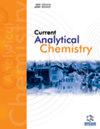Electrochemical Behavior of an Anti-cancer Drug Erlotinib at Screen-Printed Electrode and its Analytical Application
IF 1.7
4区 化学
Q3 CHEMISTRY, ANALYTICAL
引用次数: 0
Abstract
Background: Erlotinib (ERL) is a crucial tyrosine kinase inhibitor utilized for treating non-small cell lung cancer (NSCLC) and pancreatic cancer. However, due to its significant adverse effects, precise dosage monitoring is essential throughout treatments. Methods: This study developed a sensitive and specific screen-printed electrode (SPE) sensor to detect erlotinib in human serum, urine, and pharmaceutical dosage forms. The sensor's linear response range, limit of detection (LOD), and limit of quantification (LOQ) were determined. Additionally, the sensor's selectivity was assessed by studying electro-oxidation in the presence of common interfering molecules. Results: The developed sensor exhibited a linear response range of 2.0 μM to 34.0 μM, with a LOD of 0.03 μM and a LOQ of 0.84 μM. Excellent recovery values were observed in human serum, urine, and tablet dosage forms, demonstrating the sensor's applicability. The selectivity study confirmed the sensor's ability to accurately quantify erlotinib in the presence of interfering substances. Conclusion: The research presents a novel and reliable technique for therapeutic drug monitoring of erlotinib using a screen-printed electrode sensor. This method offers a quick, simple, and costeffective approach for detecting ERL in actual samples, thereby facilitating improved dosage monitoring in clinical settings.抗癌药物厄洛替尼在丝网印刷电极上的电化学行为及其分析应用
背景:厄洛替尼(ERL)是一种重要的酪氨酸激酶抑制剂,用于治疗非小细胞肺癌(NSCLC)和胰腺癌。然而,由于其明显的不良反应,在整个治疗过程中必须进行精确的剂量监测。方法:本研究开发了一种灵敏且特异的丝网印刷电极(SPE)传感器,用于检测人血清、尿液和药物剂型中的厄洛替尼。确定了传感器的线性响应范围、检测限(LOD)和定量限(LOQ)。此外,还通过研究常见干扰分子存在时的电氧化作用评估了传感器的选择性。结果显示所开发的传感器的线性响应范围为 2.0 μM 至 34.0 μM,LOD 为 0.03 μM,LOQ 为 0.84 μM。在人血清、尿液和片剂中都观察到了极好的回收率,证明了传感器的适用性。选择性研究证实,该传感器能够在存在干扰物质的情况下准确定量厄洛替尼。结论该研究提出了一种利用丝网印刷电极传感器进行厄洛替尼治疗药物监测的新颖而可靠的技术。该方法为检测实际样品中的厄洛替尼提供了一种快速、简单且经济有效的方法,从而有助于改善临床环境中的剂量监测。
本文章由计算机程序翻译,如有差异,请以英文原文为准。
求助全文
约1分钟内获得全文
求助全文
来源期刊

Current Analytical Chemistry
化学-分析化学
CiteScore
4.10
自引率
0.00%
发文量
90
审稿时长
9 months
期刊介绍:
Current Analytical Chemistry publishes full-length/mini reviews and original research articles on the most recent advances in analytical chemistry. All aspects of the field are represented, including analytical methodology, techniques, and instrumentation in both fundamental and applied research topics of interest to the broad readership of the journal. Current Analytical Chemistry strives to serve as an authoritative source of information in analytical chemistry and in related applications such as biochemical analysis, pharmaceutical research, quantitative biological imaging, novel sensors, and nanotechnology.
 求助内容:
求助内容: 应助结果提醒方式:
应助结果提醒方式:


